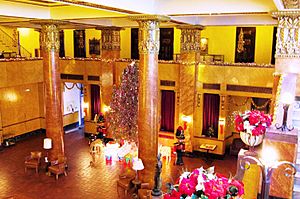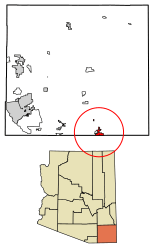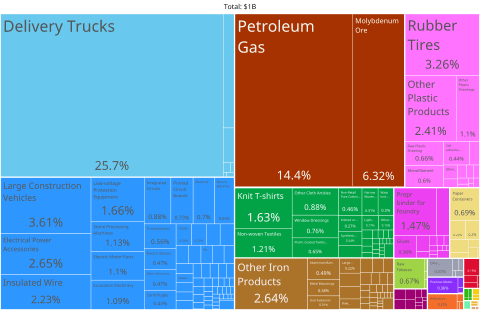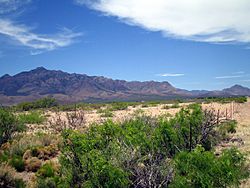Douglas, Arizona facts for kids
Quick facts for kids
Douglas
|
|
|---|---|

Lobby of Gadsden Hotel, Douglas
|
|

Location of Douglas in Cochise County, Arizona
|
|
| Country | United States |
| State | Arizona |
| County | Cochise |
| Incorporated | May 15, 1905 |
| Government | |
| • Type | Council-manager |
| • Body | Douglas City Council |
| Area | |
| • Total | 9.98 sq mi (25.85 km2) |
| • Land | 9.98 sq mi (25.85 km2) |
| • Water | 0.00 sq mi (0.00 km2) |
| Elevation | 4,032 ft (1,229 m) |
| Population
(2020)
|
|
| • Total | 16,534 |
| • Density | 1,656.88/sq mi (639.72/km2) |
| Time zone | UTC-7 (MST (no DST)) |
| ZIP codes |
85607, 85608, 85655
|
| Area code | 520 |
| FIPS code | 04-20050 |
| GNIS feature ID for the City of Douglas | 2410349 |
Douglas is a city in Cochise County, Arizona, United States that lies in the north-west to south-east running Sulpher Springs Valley. Douglas has a border crossing with Mexico at Agua Prieta and a history of mining.
The population was 17,378 at the 2010 census.
Contents
History
The Douglas area was first settled by the Spanish in the 18th century. Presidio de San Bernardino was established in 1776 and abandoned in 1780. It was located a few miles east of present-day Douglas. The United States Army established Camp San Bernardino in the latter half of the 19th century near the presidio, and in 1910 Camp Douglas was built next to the town.
Douglas was founded as an American smelter town, to treat the copper ores of nearby Bisbee, Arizona. The town is named after mining pioneer Dr. James Douglas and was incorporated in 1905. Two copper smelters operated at the site. The Calumet and Arizona Company Smelter was built in 1902. The Copper Queen operated in Douglas from 1904 until 1931, when the Phelps Dodge Corporation purchased the Calumet and Arizona Company and took over their smelter. The Calumet and Arizona smelter then became the Douglas Reduction Works. Douglas was the site of the Phelps-Dodge Corporation Douglas Reduction Works until its closure in 1987. The smoke stacks of the smelter were not taken down until January 13, 1991. The town was a site of the Arizona Copper Mine Strike of 1983.
The "Cowboys Home Saloon" was the location of the fatal shooting of bar owner Lorenzo "Lon" Bass. The accused was Arizona Ranger William W. Webb. The date was February 8, 1903.
In 1916, the Mexican revolutionary leader Pancho Villa threatened to attack Douglas, believing Americans responsible for his defeat at the Second Battle of Agua Prieta.
Geography
Douglas is located near the southeastern corner of Arizona on the U.S.-Mexico border, across from the city of Agua Prieta, Sonora.
U.S. Route 191 leads north from Douglas 69 miles (111 km) to Interstate 10 near Willcox. Arizona State Route 80 leads west 26 miles (42 km) to Bisbee and northeast 80 miles (130 km) to Interstate 10 in New Mexico.
Climate
Douglas has a semi-arid steppe climate, which is cooler and wetter than a typical arid climate classification. In the winter months, Douglas averages in the mid to upper 60s °F (17–21 °C), with both January and February averaging daily highs of 64 °F (18 °C). Lows typically settle just below the freezing mark on a majority of nights, but it is not uncommon to see temperatures tumble below 25 °F (−4 °C) on some winter nights.
On the other hand, in the summer months, highs average between 90 and 100 °F (32 and 38 °C), with the month of June being the hottest with an average daytime high of 97 °F (36 °C). Nighttime lows for the summer months remain in the upper 50s and mid 60s °F (14–18 °C) for the duration of the season. June and July typically see 6 inches (150 mm) or more of combined rainfall, which brings the average annual precipitation for Douglas to about 14 inches (360 mm).
Douglas' all-time highest recorded temperature is 111 °F (44 °C) which was reached in July, 1905. The all-time low temperature was −7 °F (−22 °C), which occurred in January 1913.
| Climate data for Douglas Bisbee Airport, Arizona | |||||||||||||
|---|---|---|---|---|---|---|---|---|---|---|---|---|---|
| Month | Jan | Feb | Mar | Apr | May | Jun | Jul | Aug | Sep | Oct | Nov | Dec | Year |
| Record high °F (°C) | 82 (28) |
86 (30) |
92 (33) |
99 (37) |
103 (39) |
110 (43) |
109 (43) |
103 (39) |
102 (39) |
95 (35) |
87 (31) |
84 (29) |
110 (43) |
| Average high °F (°C) | 62.2 (16.8) |
66.3 (19.1) |
71.4 (21.9) |
78.7 (25.9) |
86.3 (30.2) |
95.1 (35.1) |
93.5 (34.2) |
91.3 (32.9) |
88.4 (31.3) |
80.1 (26.7) |
69.8 (21.0) |
62.4 (16.9) |
78.8 (26.0) |
| Average low °F (°C) | 29.4 (−1.4) |
32.1 (0.1) |
36.4 (2.4) |
41.9 (5.5) |
50.2 (10.1) |
59.2 (15.1) |
64.4 (18.0) |
63.3 (17.4) |
58.5 (14.7) |
47.1 (8.4) |
35.2 (1.8) |
29.4 (−1.4) |
45.6 (7.6) |
| Record low °F (°C) | 6 (−14) |
10 (−12) |
13 (−11) |
21 (−6) |
29 (−2) |
40 (4) |
55 (13) |
52 (11) |
36 (2) |
19 (−7) |
5 (−15) |
−4 (−20) |
−4 (−20) |
| Average precipitation inches (mm) | 0.75 (19) |
0.64 (16) |
0.46 (12) |
0.20 (5.1) |
0.33 (8.4) |
0.63 (16) |
3.14 (80) |
2.88 (73) |
1.64 (42) |
1.30 (33) |
0.74 (19) |
1.06 (27) |
13.77 (350.5) |
| Average snowfall inches (cm) | 0.2 (0.51) |
0.1 (0.25) |
0.1 (0.25) |
0 (0) |
0 (0) |
0 (0) |
0 (0) |
0 (0) |
0 (0) |
0 (0) |
0.1 (0.25) |
0.3 (0.76) |
0.8 (2.02) |
| Average precipitation days (≥ 0.01 in) | 5.0 | 4.3 | 3.6 | 1.6 | 2.0 | 3.4 | 13.4 | 11.5 | 6.3 | 4.5 | 3.2 | 4.4 | 63.2 |
| Average snowy days (≥ 0.1 in) | 0.3 | 0.2 | 0.1 | 0 | 0 | 0 | 0 | 0 | 0 | 0 | 0.1 | 0.3 | 1 |
| Source: NOAA | |||||||||||||
Demographics
| Historical population | |||
|---|---|---|---|
| Census | Pop. | %± | |
| 1910 | 6,437 | — | |
| 1920 | 9,916 | 54.0% | |
| 1930 | 9,828 | −0.9% | |
| 1940 | 8,623 | −12.3% | |
| 1950 | 9,442 | 9.5% | |
| 1960 | 11,925 | 26.3% | |
| 1970 | 12,462 | 4.5% | |
| 1980 | 13,058 | 4.8% | |
| 1990 | 12,822 | −1.8% | |
| 2000 | 14,312 | 11.6% | |
| 2010 | 17,378 | 21.4% | |
| 2020 | 16,534 | −4.9% | |
| U.S. Decennial Census | |||
As of the census of 2010, there were 17,509 people, 4,986 households, and 3,662 families residing in the city. The population density was 1,750.9 people per square mile (676.0/km2). There were 5,652 housing units at an average density of 565.2 per square mile (218.2/km2). The racial makeup of the city was 68.2% white, 2.8% black or African-American, 1.7% American Indian or Alaska Native, 0.5% Asian, 0.1% Native Hawaiian or other Pacific Islander, 24.2% some other race, and 2.6% two or more races. 82.6% of the population were Hispanic or Latino of any race.
There were 4,986 households, out of which 45.9% had children under the age of 18 living with them, 42.9% were headed by married couples living together, 24.0% had a female householder with no husband present, and 26.6% were non-families. 23.5% of all households were made up of individuals, and 11.3% were someone living alone who was 65 years of age or older. The average household size was 2.98, and the average family size was 3.56.
In the city, the age distribution of the population was 28.2% under the age of 18, 10.4% from 18 to 24, 28.2% from 25 to 44, 21.7% from 45 to 64, and 11.5% who were 65 years of age or older. The median age was 32.2 years. For every 100 females, there were 120.7 males. For every 100 females age 18 and over, there were 127.4 males.
For the period 2008–12, the estimated median annual income for a household in the city was $28,548, and the median income for a family was $33,117. Male full-time workers had a median income of $25,853 versus $31,222 for females. The per capita income for the city was $13,376. About 25.1% of families and 30.2% of the population were below the poverty line, including 36.8% of those under age 18 and 29.0% of those age 65 or over.
Cityscape
Arts and culture
Douglas is home to the historic Gadsden Hotel, which opened in 1907. Named for the Gadsden Purchase, the stately five-story, 160-room hotel became a home away from home for cattlemen, ranchers, miners, and businessmen. The hotel was leveled by fire and rebuilt in 1929. The Gadsden is listed on the National Register of Historic Places. The Gadsden's spacious main lobby is majestically set with a solid white Italian marble staircase and four soaring marble columns. An authentic Tiffany & Co. stained glass mural extends 42 feet (13 m) across one wall of the massive mezzanine. An impressive oil painting by Audley Jean Nichols is just below the Tiffany window. Vaulted stained glass skylights run the full length of the lobby.
The San Bernardino Ranch was originally established in Mexico and covered thousands of acres. The new US-Mexico border of the Gadsden Purchase sliced through the ranch, thus reducing its US size. It is still called San Bernardino Ranch today (2009), but is still affectionately called "Slaughter's Ranch" almost 100 years after the death of John Slaughter, the owner in the late 19th century and early 20th century.
The El Paso and Southwestern Railroad depot was an important train station. It transported copper to large manufacturing concerns in the east. The depot is considered one of the finest examples of railway architecture of the early 20th century. The building is now used for the Douglas police station and is just one of 400 buildings on the National Register of Historic Places in Douglas.
The Douglas Grand Theatre was built in 1919 and was the largest theater between Los Angeles and San Antonio. Ginger Rogers, Anna Pavlova and John Philip Sousa are some of the famous faces to have graced the theater's stage. It also housed a tea room, candy store and barbershop in its glory days. For several Halloweens the Grand Theater was used as a "Haunted House" attraction. Today (2009) the theater is undergoing reconstruction, using private donations of money, supplies and labor.
Cemeteries
The Douglas Jewish Cemetery was founded in 1904 near the Mexican border. It has nineteen recorded graves, and thirteen of the tombstones are not necessarily on the correct grave sites due to extensive vandalism. The cemetery was in use from 1912 to 1963. The cemetery was restored, re-fenced and cleaned in 1992 by students and numerous others. The cemetery is included in the State of Arizona of Historical Places. In November 2012, two gravestones were shattered in the Jewish cemetery in the town, in what seemed to be an anti-Semitic act.
Transportation
The City of Douglas operates Douglas Rides, which provides local transportation. The city also operates Cochice Connection, which provides connections between Douglas, Bisbee, and Sierra Vista. Private shuttle services connect Douglas with Tucson and Phoenix.
Douglas is connected to Agua Prieta by the Douglas, Arizona Port of Entry.
Popular culture
Film
- The Life and Times of Judge Roy Bean (1972)
- Arizona Dream (1993)
- Pontiac Moon (1994)
- Terminal Velocity (1994)
| Wikisource has the text of a 1921 Collier's Encyclopedia article about Douglas, Arizona. |
Education
Public schools
The Douglas Unified School District is responsible for public education. Schools include:
- Clawson Elementary School
- Douglas High School
- Faras Elementary School
- Joe Carlson Elementary School
- Paul H. Huber Middle School
- Sarah Marley Elementary School
- Stevenson Elementary School
- Ray Borane Middle School
Private schools
- CAS Elementary, Middle, and High School
- Loretto Catholic School
- Omega Alpha Academy K-12 Charter School
Notable people
- John D. Driggs, 50th mayor of Phoenix
- Manny Farber, stylist, film critic, and painter
- Evelyn Finley, actress and Hollywood stuntwoman
- Harold L. Humes (1926–1992), novelist and founder of The Paris Review literary magazine
- Stan Jones (1914–1963), musician
- Gil Lefebvre (1910–1987), football player
- Lorna E. Lockwood, first female chief justice of a state supreme court
- Bill Melendez, animator, film producer, and film director; best known as the voice of Snoopy and Woodstock
- Mike Pagel, former NFL quarterback
- Jack Lund Schofield, Nevada state legislator
- "Texas John" Slaughter, Cochise County Sheriff (1841–1922), rancher, gunfighter, businessman, and a champion for Arizona's statehood
- Effie Anderson Smith (1869–1955), impressionist painter of desert landscapes
- Thornton Wilder, Pulitzer Prize-winning playwright and novelist
See also
 In Spanish: Douglas (Arizona) para niños
In Spanish: Douglas (Arizona) para niños





